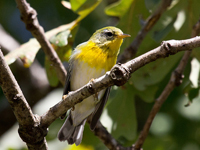| Please Report Your Sightings! |
I can attest first-hand that spring songbird migration is here! I took my ornithology class (ornithology is the study of birds) down to the South Carolina coast for a few days to see species and habitats they don’t see here in Tennessee. (For one student, it was her first time seeing the ocean!) The weather was great—sunny and warm.
Last Week's Gulf Coast/Southern Arrivals
The southerly winds that gave us the warm temperatures also brought in some of the early migrating species. We saw lots of Tree Swallows, along with Yellow-throated Warblers, Blue-gray Gnatcatchers, and a Black-and-white Warbler.
Early migrants have been showing up all along the Gulf Coast, especially Purple Martins and Northern Parulas. Northern Rough-winged Swallows were also seen in Louisiana. A few of the birds have been able to make it a little farther north, with Purple Martins making to Oklahoma, and Tree Swallows showing up here in Tennessee.
Western Arrivals
It is a similar story out West, with birds trickling in. Hooded Orioles were seen in both Arizona and California, Western Kingbirds were seen in New Mexico, and Warbling Vireos arrived in California.
 |
| Photo: David Aborn |
| Dr. David Aborn |
 |
| Photo: Laura Erickson |
| Northern Parula |
 |
| Photo: Laura Erickson |
| Blue-gray Gnatcatcher |

-
A series of slow moving fronts is making its way across the country, and that will bring lots of rain to the eastern half of the US for most of the week. Winds behind the fronts are not very strong, but the rain will make for poor flying conditions. Birds that are here won’t be able to make much progress north, and any new arrivals will be stuck along the Gulf Coast.
-
The situation isn’t much better in the West. A series of low-pressure areas is pulling moisture in from the Pacific Ocean and creating rainy conditions out there. As in the East, birds won’t be able to do much flying, so birders farther north will have to wait a little while longer before they might see their first migrants.
Seeing those first migrants in South Carolina has got me pumped up for the weeks to come. If there are any breaks in the rain, you should get out there and see what might be in your area!
Take care.
David Aborn
North Chickamauga Creek Conservancy
Chattanooga, TN


